Rainbow Six Siege
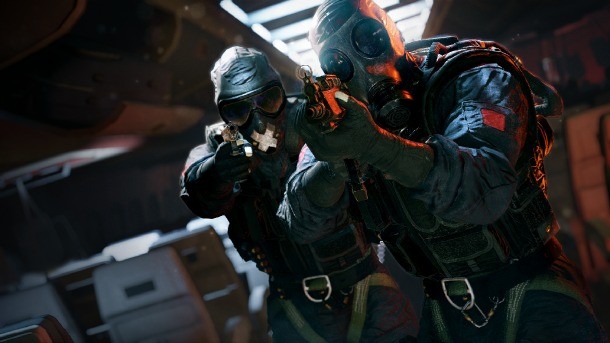
At the start of the Xbox 360 generation, the Rainbow Six Vegas games were two of the most highly rated and popular military shooters. In the seven years since, a lot has changed. Call of Duty became a multi-billion dollar juggernaut, Battlefield found its footing in the console space, and new games like Insurgency joined the fray to fill the tactical void created by Team Rainbow's long absence.
After a promising reboot was shelved due to development troubles, Ubisoft Montreal is finally gearing up to re-enlist its beloved series for another tour of duty. Rainbow Six Siege preserves many of the tenants of the series - tactical gameplay, close-quarters firefights, and a heavy focus on competitive multiplayer - but the years away from battle has made Ubisoft reexamine what makes the series special. The development team is experimenting with ways to re-enter the competitive multiplayer space not with a stealth maneuver, but with a loud and impactful breaching charge that disrupts the landscape and potentially gives the series a leg up on its direct competitors.
At a recent event in Montreal, we checked out the game for the first time since E3. Our second rendezvous with Siege shared many similarities with the first - a hands-on demo of the eponymous Siege mode. This asymmetrical mode pits two teams of five against one another in a close quarters indoor environment. The defending team must protect the hostage at all costs, while the assaulters try to extract the VIP in less than three minutes. Each player only has one life, so if all of the members of one of the teams die then the round also comes to an end. Team roles rotate after each round, and the first team to four wins is victorious.
On paper, the mode sounds rather conventional. Once the bullets start flying, you realize that while this gameplay may feel familiar, it's being stitched together in a new way that could be just what Ubisoft needs to recruit lapsed fans back into the fold. Here are six of the standout features that we think give Rainbow Six Siege a fighting chance to be a destination shooter when it releases later this year.
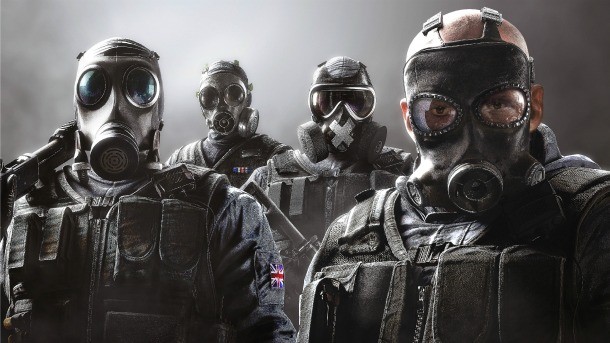
HERO OPERATORS
Most shooters give players the choice of a particular soldier class and then let them tailor loadouts to their liking. Instead of following this well-worn path, Rainbow Six Siege is taking a page from the popular MOBA scene by crafting 20 individual operators, each with a distinct personality, weapon selection, and special ability.
Keeping with tradition, these soldiers hail from elite counterterrorism units from around the globe. Ubisoft says players can expect characters that hail from the FBI SWAT, British SAS, Russian Spetsnaz, German GSG9, and French GIGN. Given the asymmetrical nature of the battles in Siege mode, each operator is tailored for either offense or defense. We gained a glimpse at five operators from each side of the skirmish in a preview of the closed alpha content.
ASSAULT
Name Special Ability
Ash Breach charge projectile that can be fired from a distance
Sledge Sledgehammer that can punch through destructible surfaces
Thatcher EMP grenades that disable nearby electronics
Thermite Thermite breaching charge that can punch through reinforced walls
Twitch Drone that disables traps and deals small amounts of shock damage
DEFENDERS
Name Special Ability
Castle Barricades that can sustain more damage than regular fortifications
Mute Jamming device that prevents remote detonation and disrupts drone signals
Pulse Heartbeat monitor that detects nearby enemies
Rook Armored vests that can be dispersed among teammates
Smoke Toxic gas grenade that can slow assaults to a halt
Both the attacking and defending teams have access to a Recruit character as well, a jack of all trades master of none who has no special ability but can take more conventional tools like breaching charges and grenades into the battle.
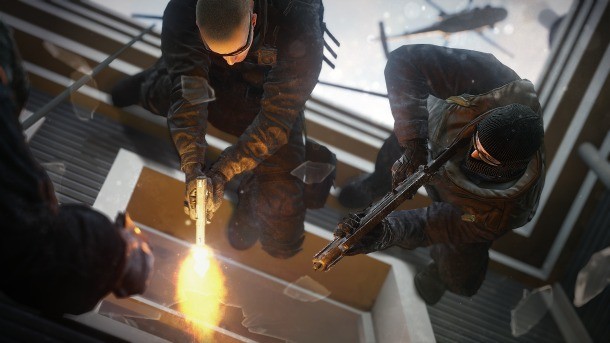
MAKING PRE-GAME PLANNING INTERESTING
In the early days of Rainbow Six, pre-mission planning was a tedious process of analyzing the environment and then placing waypoints for your squad to follow. This simulation level of strategy won't fly in modern shooters. Instead, Ubisoft Montreal is giving each player tools to prep for the inevitable encounter during a brief pre-game mission.
Before spawning into a map, both defenders and attackers are given the chance to vote where on a map they should spawn. This is especially critical for the defending team, as it determines where the hostage will be located. Each spot has different strengths and weaknesses. For instance, by holing up in the basement of the house, the defenders only have to cover two doors - the large garage door and a staircase leading to the back of the basement. This doesn't mean these are the only places a team can attack; since the environments are destructive they could just blow through the wall or ceiling. What you gain in covering fewer traditional entryways you lose in being able to see where the attack is coming from.
After the starting positions are decided, then each team has a small window of time to set up for the assault. Defenders can make things difficult by reinforcing walls, laying down traps like barbed wire, and barricading doors and windows. Meanwhile, each player on the attacking team navigates a small drone to try and locate the hostage and analyze the fortifications. If the defenders spot these drones maneuvering through the building, they can disable them with a melee attack or well-placed bullet.
GIVING ASSAULTING TEAMS A DEADLINE
When you are only given one life in a game mode, you approach your goals quite differently than when you're on the Call of Duty spawn-die-respawn reincarnation wheel. Players proceed more cautiously, staying behind cover and moving at a slower pace. In many previous games this has seriously hindered the pace of the action, but Rainbow Six Siege compels the attackers to move quickly thanks to the deadline.
With only three minutes to extract the hostage or eliminate every enemy target, camping isn't an option. Teams must coordinate their movements and attack with purpose. This forced urgency helps Siege mode find a sweet spot between the frantic action of a Call of Duty round and the more measured, tactical approach of more realistic shooters.
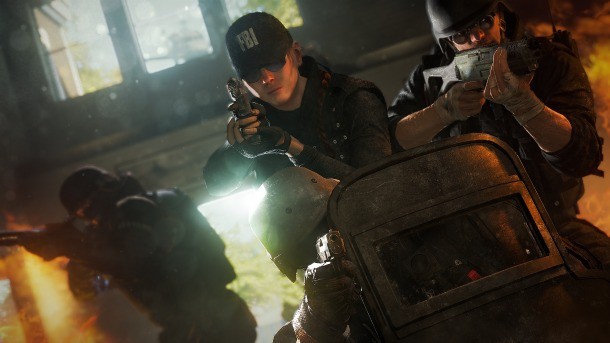
MAKING DEFENDING FUN AGAIN
Defense often isn't as fun as being on the offensive in video games. Madden fans found it so boring that EA put in a supersim feature that allowed players to fast-forward to their next offensive possession. Battlefield players on the Bad Company servers would drop out of protecting M-COM stations in Rush mode in favor of finding another game where they could attack - a decision I never wrapped my head around considering how many points you could rack up protecting your position. This aversion to defending shouldn't be a problem with Siege.
When you only have to put up your defenses for three minutes and the opposing team has no respawns, the prospect of camping on a position isn't nearly as off-putting. Making matters better are some of the cool gadgets operators get to use while protecting a hostage. The heartbeat monitor is a great tool for tracking enemy movement through walls, strategically placed jammers can muck up the communications of the opposing team, and tossing a gas grenade at the perfect time could quickly wipe out an approaching group of attackers. The variety of tools at players' disposal should allow for some tactical experimentation.
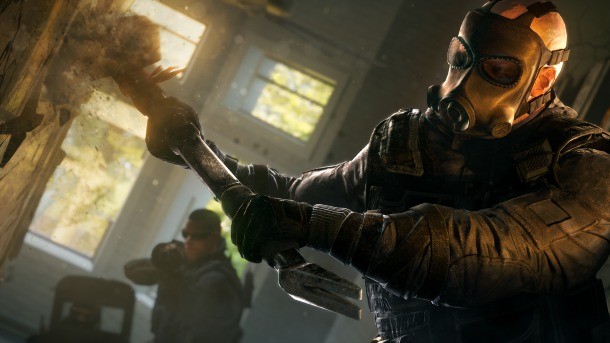
FEATURING DESTRUCTIBILITY AS A CORE GAMEPLAY TENET
When DICE debuted destructible environments in Battlefield: Bad Company, we expected it to eventually become a pervasive a feature in first-person shooters. Destroying cover positions, firing through walls, and the ability to level entire buildings seemed like a natural evolution for any shooter featuring heavy ordinance. That never materialized, as even DICE started to tone down its use in Battlefield to micro-destruction for close-quarters maps and the horribly named "Levolution" set-piece events that change the way a map plays.
To create more chaos in Siege's short-range firefights, Ubisoft Montreal is using its proprietary Anvil engine to make destruction a central part of the experience. "We really wanted a game that's all about exercising player creativity within a sandbox," says game designer Andrew Witts. "The destruction was the first piece of that - bending the environment to your will in terms of breaching and making new opportunities for yourself."
Destructibility works both ways. Defenders could use the heartbeat tracker to locate the attackers on the other side of the wall and then take them out through the drywall. Attackers can set breaches on any wall to create a new point of entry.

GIVING PLAYERS PURPOSE AFTER DEATH
In elimination round play, the dead players often have nothing to do except think about what went wrong as the match continues without them. Rainbow Six Siege puts these players to work by giving them access to the various cameras positioned throughout the environment so they can feed intel to the surviving players.
The defenders have access to the security camera feeds, provided the attackers haven't identified their positions and put a bullet through the lens. If the attacking team was smart, they strategically placed their drones in valuable positions during the pre-game scouting and weren't spotted. Calling out enemy positions and informing your surviving teammates of their movement can spell the difference between winning and losing the round.
Ubisoft plans to start the closed alpha testing period in the coming weeks. Register here if you'd like to be considered as a participant.










